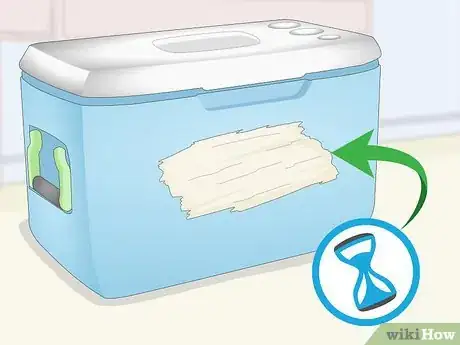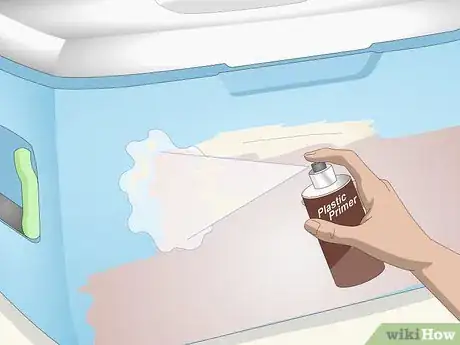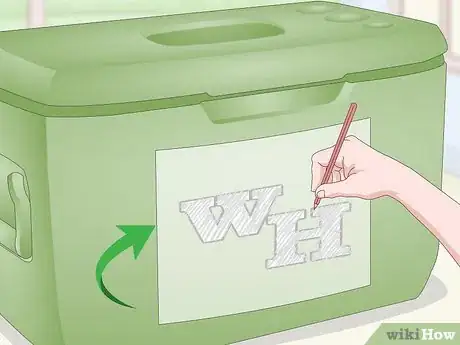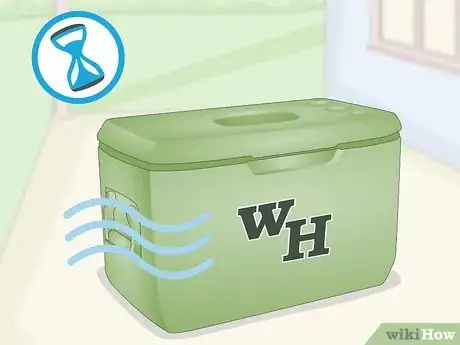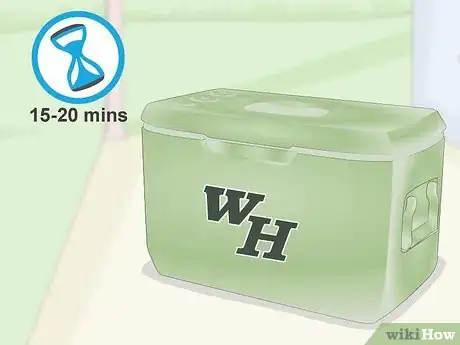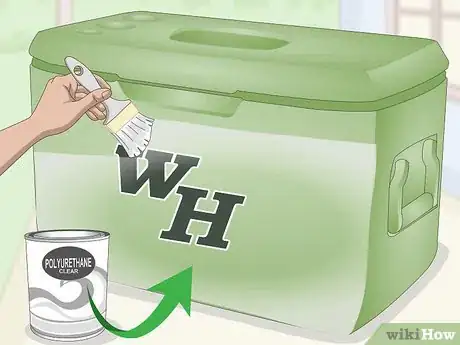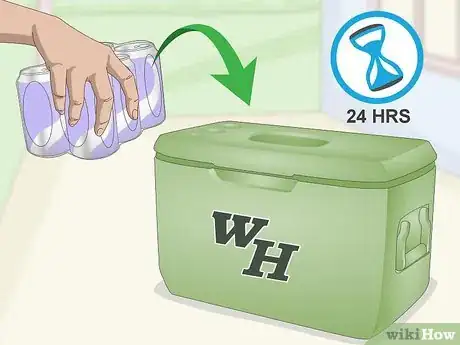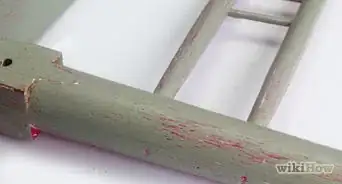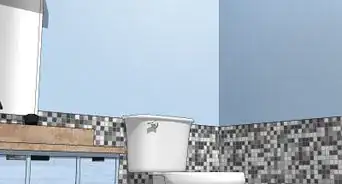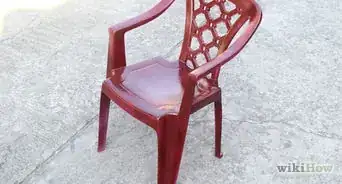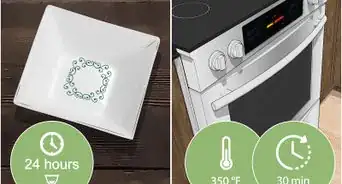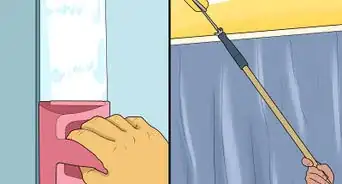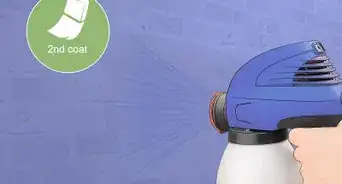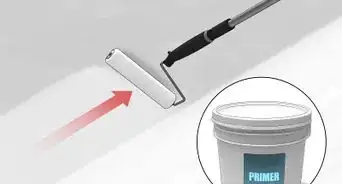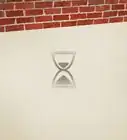This article was co-authored by Patrick Coye and by wikiHow staff writer, Kyle Hall. Patrick Coye is the owner and operator of Patrick’s Painting & Home Improvement in Alexandria, Virginia. With over 15 years of experience in residential construction, Patrick specializes in painting, wallpaper removal/installation, drywall, staining decks and fences, and kitchen cabinetry painting. To date, Patrick and his team have painted over 2,000 houses and stained over 800 decks. Patrick's Company won a "Top Job" award from the American Painting contractor magazine in 2020.
This article has been viewed 320,501 times.
When you're painting a cooler, the color choices and design possibilities are endless. If you take the time to prime, paint and seal your cooler correctly, you'll have a personalized keepsake that you can use for years to come.
Steps
Priming the Cooler
-
1Fill in any logos or indents on the cooler with spackle. Spackle is a putty used as a filler. It hardens when it dries, so you’ll be able to paint right over it later on. Use a putty knife to fill the indents with spackle. Scrape the edge of the knife over the top of the spackle so it’s flush with the rest of the cooler. Don’t worry if it’s not perfect — you can sand it down later.[1]
-
2Let the spackle dry for several hours. The exact amount of time it will take the spackle to dry depends on how deep the indents you filled in were — the deeper the indents, the longer it will take to dry. After a few hours, try touching the spackle with your fingers. If it's hard and has a chalky texture, it's dry.Advertisement
-
3Sand the surface of the cooler once the spackle is dry. Sanding the cooler will make it easier for the paint to stick to it. You want to sand the cooler just enough to take away the shine and give the surface a little bit of a grit. Don’t forget to sand over the spackle, so it’s flush with the rest of the cooler.
- Give the cooler a hard sand using 120-grit sandpaper. This will scuff the surface enough that the primer will be able to adhere to the surface of the cooler.[2]
- For a smoother finish, start sanding the cooler with a coarse grit sandpaper (40-50 grit) and finish with a fine grit sandpaper (120-220 grit). Using 2 kinds of sandpaper will help you make your cooler as smooth as possible.[3]
- If the cooler came with a smooth finish, you still want to sand it down to remove the top layer of the plastic so the paint sticks.
-
4Apply a spray-on plastic primer to the surface of the cooler. A plastic primer will help the paint adhere to the surface of the cooler better.[4] Spray the primer on the cooler so there’s an even coat over the entire surface.
- You can find a spray-on plastic primer at your local home improvement center or paint store.
- If the cooler has handles or wheels that you don’t want to paint, cover them with painter’s tape before you spray the primer on.
-
5Let the cooler dry in a well-ventilated area for 24 hours. Place the cooler on a tarp or sheets of newspaper while it dries so the primer doesn't get on your floor. After 24 hours, the cooler should feel dry to the touch. If it's not, let it finish drying.
Designing and Painting the Cooler
-
1Paint the cooler background with acrylic paint. Before you add designs or personal touches, you should create a solid base to work on. Cover the sides and top of the cooler with paint using a large paintbrush.
- To use multiple colors for the background, paint 1 color at a time and let the paint dry in between colors.
- One coat of acrylic paint should be enough for the background.
- For a harder finish, try using enamel paint, rather than acrylic.[5]
-
2Let the paint dry for 24 hours. After 24 hours, the cooler should feel dry to the touch. If you're doing additional colors for the background, paint them on one at a time and let the cooler dry for 24 hours in between each coat.
-
3Print out any designs or lettering you want to put on the cooler. While you can definitely draw designs on the cooler freehand, using designs printed off the computer will make the cooler look cleaner and more professional.[6]
- Keep in mind that you’ll be tracing the outlines of the designs onto the cooler and filling them in with paint, so stick with simple images and fonts.
-
4Trace the designs and lettering onto the cooler using carbon paper. To use carbon paper, trace the outline of your design onto the paper. Then, hold the carbon paper on the cooler and draw over the lines to transfer the design onto the cooler.[7]
- You can find carbon paper online or at your local art supplies store.
-
5Use printer paper to transfer your designs if you don't have carbon paper. Start by tracing your design onto a sheet of printer paper. Then, shade in the back of the paper with pencil. After the back is shaded in, place the paper on the cooler where you want the design to go and trace over the lines with a pencil to transfer it.[8]
-
6Try tissue paper if you don't have carbon printer paper. Trace your design onto a piece of tissue paper. Then, position the tissue paper on the cooler where you want the design to go and draw over the outline with a fine-point permanent marker. The marker will bleed through the tissue paper and transfer onto the cooler.[9]
-
7Fill in the designs and lettering with acrylic paint. Use small paint brushes to apply the paint so you can be more detailed.
- If you want to do multiple colors in the same design, do 1 color at a time and let the paint dry in between colors — otherwise, the colors might smudge together.
- It may be easier if you lay the cooler on its side so the side you're painting is facing up. If you do this, you'll need to paint 1 side at a time and let the paint dry in between sides.
-
8Let the painted designs and lettering dry for several hours. The thinner the coat of paint, the less time it will take to dry. After a few hours, touch the paint to see if it's completely dry. If it is, you can add additional colors to your designs, start on a new side of the cooler, or move on to sealing the cooler.
Sealing the Cooler
-
1Apply a coat of spray-on Mod Podge to the surface of the cooler. Mod Podge is a sealer and finisher that will help prevent the paint on the cooler from chipping or peeling. Once the paint on the cooler is dry, spray the surface of the cooler with a thin, even coat of Mod Podge.
- You can find Mod Podge online or at your local arts and crafts store.
-
2Let the first coat of mod podge dry for 15-20 minutes. After 15-20 minutes, the Mod Podge should feel completely dry to the touch. If it doesn't, let it finish drying before you move on.
-
3Apply a second coat of Mod Podge and let it dry. Two coats of Mod Podge should be enough to protect the paint on the cooler from chipping or peeling. After you spray the second coat, let the cooler dry for another 15-20 minutes before moving it.
-
4Cover the cooler with a thin layer of clear polyurethane to waterproof it. Since coolers have a tendency to get wet, it’s a good idea to waterproof your cooler so the paint doesn’t come off. Use a clean paintbrush to apply a thin, even layer of clear polyurethane to the entire outer surface of the cooler.[10]
- You can find polyurethane online or at your local home improvement center.
-
5Let the cooler dry for 24 hours before you use it. After 24 hours, the cooler should be completely dried, sealed, and ready to go. If you covered the handles and wheels with painter’s tape, you can take the tape off now.[11]
Expert Q&A
Did you know you can get expert answers for this article?
Unlock expert answers by supporting wikiHow
-
QuestionWhat kind of paint do you use on a cooler?
 Patrick CoyePatrick Coye is the owner and operator of Patrick’s Painting & Home Improvement in Alexandria, Virginia. With over 15 years of experience in residential construction, Patrick specializes in painting, wallpaper removal/installation, drywall, staining decks and fences, and kitchen cabinetry painting. To date, Patrick and his team have painted over 2,000 houses and stained over 800 decks. Patrick's Company won a "Top Job" award from the American Painting contractor magazine in 2020.
Patrick CoyePatrick Coye is the owner and operator of Patrick’s Painting & Home Improvement in Alexandria, Virginia. With over 15 years of experience in residential construction, Patrick specializes in painting, wallpaper removal/installation, drywall, staining decks and fences, and kitchen cabinetry painting. To date, Patrick and his team have painted over 2,000 houses and stained over 800 decks. Patrick's Company won a "Top Job" award from the American Painting contractor magazine in 2020.
Painting Specialist
-
QuestionHow long do I leave the Mod Podge on?
 Community AnswerYou leave it on for one to three days.
Community AnswerYou leave it on for one to three days.
Things You’ll Need
- Cooler
- Spackle
- Putty knife
- Coarse grit sandpaper
- Fine grit sandpaper
- Spray-on plastic primer
- Tarp or newspaper
- Painter’s tape
- Acrylic paint
- Paintbrushes
- Carbon or tissue paper
- Printer
- Printer paper
- Pencil
- Mod Podge
- Polyurethane
References
- ↑ https://totalsororitymove.com/how-to-paint-a-cooler-for-dummies-the-be-all-end-all-guide/
- ↑ Patrick Coye. Painting Specialist. Expert Interview. 22 July 2020.
- ↑ https://www.youtube.com/watch?v=aTTflEIH6wk&feature=youtu.be&t=163
- ↑ Patrick Coye. Painting Specialist. Expert Interview. 22 July 2020.
- ↑ Patrick Coye. Painting Specialist. Expert Interview. 22 July 2020.
- ↑ https://totalsororitymove.com/how-to-paint-a-cooler-for-dummies-the-be-all-end-all-guide/
- ↑ https://www.youtube.com/watch?v=aTTflEIH6wk&feature=youtu.be&t=306
- ↑ https://www.youtube.com/watch?v=aTTflEIH6wk&feature=youtu.be&t=306
- ↑ https://www.youtube.com/watch?v=aTTflEIH6wk&feature=youtu.be&t=306
About This Article
Before you paint your cooler, spackle and sand any logos or indentations, then spray on a plastic primer and let it dry for 24 hours. Then, apply 1 coat of acrylic paint, and let it dry for another 24 hours. Next, draw or trace the design you want onto carbon paper, and use the carbon paper to transfer the design onto the cooler before using acrylic paint to outline or fill in your design. When the paint is dry, apply 2 coats of Mod Podge to seal your cooler, and a coat of polyurethane to waterproof it. For tips on transferring a design to your cooler using printer paper or tissue paper, read on!

